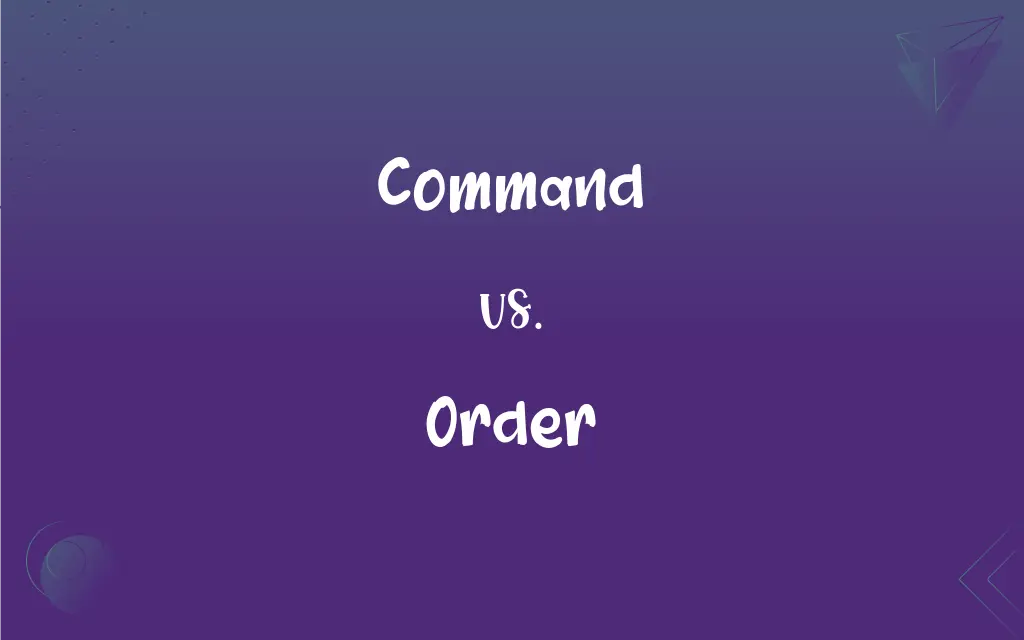Command vs. Order: What's the Difference?
Edited by Aimie Carlson || By Harlon Moss || Published on January 11, 2024
A command is a directive given with authority, often implying control and specific expectations, while an order is a more general instruction or request for something to be done or provided.

Key Differences
Command implies the exercise of authority and often conveys a sense of urgency or importance. It is typically used in situations where obedience is expected, such as in military or organizational contexts. Order, on the other hand, can be a formal request or instruction but does not inherently carry the same weight of authority. It is often used in everyday situations, like placing an order in a restaurant.
In the context of communication, a command often comes from someone in a higher position and is expected to be followed without question. It is a direct and authoritative instruction. Order, conversely, can be given by anyone and may not necessarily come with an expectation of strict obedience. It can be a mere arrangement or organization of things.
When discussing functionality, a command often implies a specific task to be completed, usually within a structured framework or system. It has a connotation of control and directiveness. In contrast, an order can refer to the way things are arranged or a sequence, not just a directive. It can be more flexible and less authoritative than a command.
In a technological context, a command is a specific instruction given to a computer or machine, prompting a particular response. It's precise and exact. An order in this context might refer to a sequence of operations or a request for a service or product, indicating a broader range of applications.
The tone and implication of a command generally convey a non-negotiable directive, often used in urgent or critical situations. It suggests an expectation of compliance. An order, however, can be a simple request or instruction that does not inherently carry a sense of urgency or the expectation of immediate action.
ADVERTISEMENT
Comparison Chart
Authority
Implies higher authority and control
Can be given by anyone, less authoritative
Tone
Typically more direct and forceful
Often more polite or formal
Context of Use
Common in military, technical, or urgent contexts
Used in everyday, commercial, or organizational settings
Compliance Expectation
Expected to be followed without question
May allow for negotiation or refusal
Connotation
Often associated with urgency or importance
More neutral, can imply arrangement or sequence
ADVERTISEMENT
Command and Order Definitions
Command
Exerting Dominance.
He commanded silence in the room.
Order
Organizational Structure.
The company maintains a strict order.
Command
Controlled Request.
She commanded her dog to sit.
Order
Purchase Request.
I placed an order for a pizza.
Command
Computer Instruction.
Enter the command to start the program.
Order
Calm Restoration.
The officer restored order in the crowd.
Command
Authority Directive.
The general issued a command to retreat.
Order
Judicial Instruction.
The judge issued a restraining order.
Command
Mastery Display.
The pianist commanded the stage with skill.
Order
Sequence Arrangement.
The books are in alphabetical order.
Command
To direct with authority; give orders to.
Order
A condition of logical or comprehensible arrangement among the separate elements of a group.
Order
A condition of methodical or prescribed arrangement among component parts such that proper functioning or appearance is achieved
Checked to see that the shipping department was in order.
FAQs
Is a command always authoritative?
Yes, a command typically implies authority and control.
Can an order be a casual request?
Yes, an order can be a casual request or a formal instruction.
Can anyone issue a command?
Generally, commands are issued by those in authority or control.
Can orders be refused?
Orders can sometimes be negotiated or refused, depending on context.
What does command mean?
Command refers to an authoritative directive or instruction.
What does order mean?
Order refers to a request or instruction, or an arrangement or sequence.
Are commands negotiable?
Commands are generally not negotiable and are expected to be followed.
Where is order commonly used?
Order is used in a wide range of contexts, from restaurants to legal systems.
Can order refer to peace or stability?
Yes, order can refer to maintaining peace or stability in a group.
Does order always imply a sequence?
Not always, but order often involves an arrangement or sequence.
Is a command always verbal?
No, commands can be written or signaled, not just spoken.
Does command imply immediate action?
Often, commands imply an expectation of immediate action.
Can order imply a method or system?
Yes, order can imply a systematic or methodical arrangement.
Do commands and orders always come from people?
Primarily, but they can also come from systems or protocols in some contexts.
Is command used in military contexts?
Yes, command is commonly used in military and similar hierarchical structures.
Can command imply expertise?
Yes, in some contexts, commanding can imply mastery or expertise.
How does tone differ in command and order?
Commands are often more direct; orders can be more polite or formal.
Is an order a request for action?
Yes, an order typically requests an action or arrangement.
Can order be used in technology?
Yes, order can refer to sequences in programming or operations.
Is a command always serious?
Commands are often serious, especially in urgent or critical contexts.
About Author
Written by
Harlon MossHarlon is a seasoned quality moderator and accomplished content writer for Difference Wiki. An alumnus of the prestigious University of California, he earned his degree in Computer Science. Leveraging his academic background, Harlon brings a meticulous and informed perspective to his work, ensuring content accuracy and excellence.
Edited by
Aimie CarlsonAimie Carlson, holding a master's degree in English literature, is a fervent English language enthusiast. She lends her writing talents to Difference Wiki, a prominent website that specializes in comparisons, offering readers insightful analyses that both captivate and inform.







































































